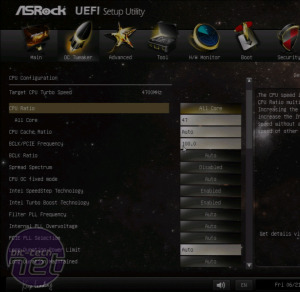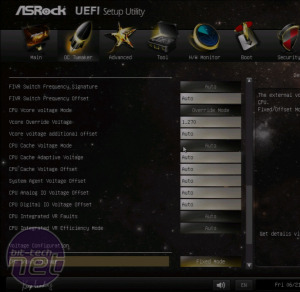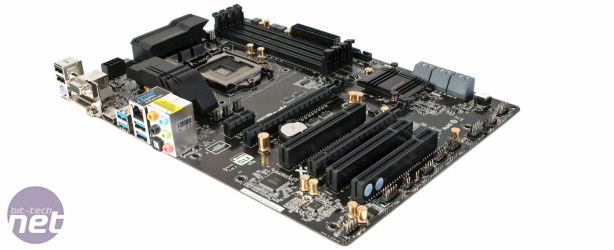Overclocking
Delving into the EFI BIOS reveals a well laid out old-school approach to BIOS design with none of the overly flashy menus and visuals of some EFIs. The main screen displays the current board status and hardware frequencies, while all the overclocking options are neatly displayed in the OC Tweaker menu. A special mention must also be made of Asrock’s unique Internet Flash BIOS option, which is capable of going online, downloading the latest BIOS and then applying it, all from within the BIOS and without installing a network driver - it's still hands down the best BIOS update facility out there.We set about overclocking the Extreme3 and it happily booted at 4.7GHz (47x100) with a VCore of 1.27V. However, under load the CPU quickly hit the 100°C TJmax of our Haswell Core i7-4770K CPU and throttled down. Dropping the voltage to 1.24V didn’t resolve this, with the CPU continuing to overheat in our 23°C air-conditioned labs. In the end we were forced to drop the frequency to 4.6GHz and the voltage to 1.2V, wherein we found the overclock benchmark and Prime95 stable at around 95°C. While this might look disappointing (the Extreme3 is the first ATX Z87 motherboard we’ve tested to not sustain a 4.7GHz overclock), in end-users systems we don’t recommend this level of overclock on a day-to-day basis due to the high thermals - if we’d tested in a heat wave temperature office we’d have likely had to hold back even further.
Performance
The Extreme3 failed to impress in our suite of Media Benchmarks at stock, producing the lowest scores we’ve seen from a Z87 motherboard in all three tests. An overall score of 2,346 points is five per cent slower than the £115 MSI Z87 G45-Gaming and seven per cent slower than the Asus Maximus VI Hero – not a good start for the Extreme3.In 3D games it fared better, with a minimum frame rate of 94fps in Skyrim bettering the 91fps minimum many boards achieve in the same test. Shogun 2 returned the Extreme3 to the bottom of its pile though, with a minimum frame rate of 27fps. Again, the margins are small, but there’s no denying that the Extreme3 is the slowest Z87 board we’ve tested at stock.
Bumped to 4.6GHz (46x100) the Extreme3 performed much better, with the 100MHz handicap not stopping it from competing with the 4.7GHz competition. An Image Editing score of 2,460 points matches that of the Rampage VI Extreme, while a Video Encoding score of 4,315 points bests the Gigabyte GA-Z87X-UD3H. A Multi-tasking score of 1,780 is just 4 points behind the Maximus VI Hero, producing an overall score of 2,851 points, just 67 points (or two per cent) slower than the quickest Z87 board we’ve tested.
3D performance was still a little lacking however, even when overclocked. A minimum frame rate of 104fps in Skyrim is the lowest result we’ve seen from an overclocked Z87 board (albeit by just 1fps), while a minimum frame rate of 34fps in Shogun 2 is five per cent slower than some of the competition.
The Extreme3 does come up trumps in one category though – power consumption. An idle system power load of just 60W is very low indeed, while a peak load of 122W is the lowest we’ve seen. When overclocked power consumption remains low, topping out at 87W when idle and 190W under prime95 load.
Conclusion
While we might have talked about how the Asrock Z87 Extreme3 is the slowest Z87 board we’ve yet tested, it’s important to remember that the margins between boards are incredibly slim. Even at stock the biggest difference between it and a board more than twice its price is just seven per cent, and when overclocked this dropped to no more than two per cent, even with the 100MHz peak-overclock handicap.While it’s not fair to class the Extreme3 as a slow board then, it’s still far from perfect, especially considering its £130 price tag. While attractive and reasonably well laid out its feature set is very much by-the-numbers, with few of the nice little extras we like to see such as on-board buttons and POST-code readouts. This would be fine if it were priced more competitively, but at £132 you’d only have to spend an extra £15 to net yourself a Gigabyte Z87X-UD3H, replete with every on-board button you’d need. If such extras are of no consequence to you, then MSI’s Z87-G45 Gaming is £15 cheaper and offers a near identical feature set to the Extreme3.
While by no means a bad board, Asrock looks to have gotten the price/features balance a bit wrong with the Extreme3, leaving it stuck between better featured boards which demand a minimal premium, or cheaper competition which matches it feature for feature. Unless it receives a price cut to allow it compete, there are plenty of better choices elsewhere.

-
Performance41 / 45
-
Features18 / 30
-
Value18 / 25


MSI MPG Velox 100R Chassis Review
October 14 2021 | 15:04













Want to comment? Please log in.